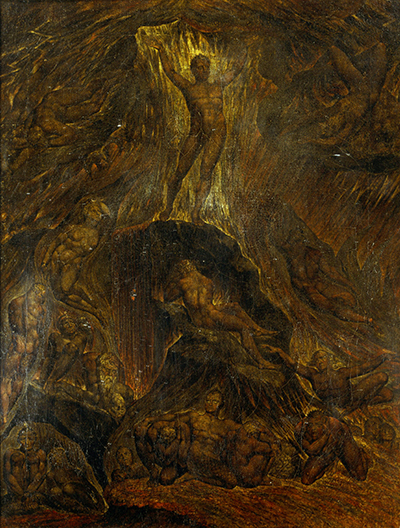Satan Calling His Legions is a tempera painting by William Blake from 1805 to 1809. The Countess of Egremont commissioned Blake to work on the painting using tempera on canvas. The countess was an amateur artist. It shows John Milton's Paradise Lost scene, one of the works that Blake greatly admired.
The Technique
Blake uses symbolism to paint Satan Calling His Legions. He used the tempera on canvas technique where he painted using pigment ground in a water-soluble medium. At the time, this was an experiment to see how it would turn out, although he had used the tempera on canvas technique of two previous paintings. He painted in glasses on top of gold leaf and used pen and watercolour.
Illustration
In the painting, Satan is the focus subject. He is standing on a rock in the centre, surrounded by flames. A man in a crown sits on a rock below him while figures float in the fire to his left and right. The condemned are below the crowned seated figure on molten rock. A man with scaly thighs sits in the centre, holding two huddled people. Satan has his arms outstretched in the upper centre of the composition. He is standing in front of flames that illuminate him. The rest of the figures are in shadow and darkness. His shield and spear are laid against a rock behind him on his right.
Blake used dark colours to illustrate the darkness and the fallen state of Satan and his rebel angels after being cast out of heaven. The posture of the figures is in a sad state, with their bodies slumped in dejection and their facial expressions morose. The gold tones show fire coming from an opening behind Satan that falls on some of the figures around him. The focus of light on him draws the viewer's eye to him. Michelangelo's influence on Blake's work is seen in the form of the demon figures. They are similar to artwork Blake did previously and subsequently. In this painting, similar to other Blake religious paintings, the figures do not wear any clothing.
The Inspiration
The painting is a depiction of the first book of Paradise Lost. God casts out Satan, who rallies the angels who have been cast out with him. He plans to re-enter heaven by force. The artwork is one of Blake's pieces heavily influenced by religious works.
Location
The painting was a gift from the late W. Graham Robertson estate in 1950 to the Victoria and Albert Museum in London, where it is currently displayed.




